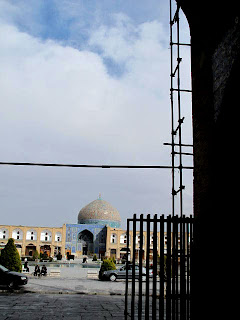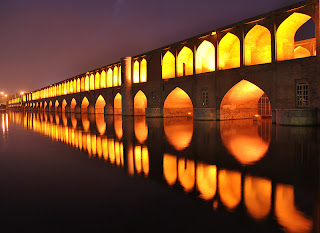My photos of the beautiful and historic city of Iran- Isfahan
You can see some photos that i took in my last journey to Isfahan and visit Nghsh-i Jahan Squer.
Alighapoo-Sixth floor(Music Room)
There are deep curvy niches cut on the walls in form of shelves which account for the pleasing sound effects in the room.This room is also tastefully decorated,but the quality of the room it's a main attraction.
Sheikh Lotfollah mosque:
Sheikh Lotfollah Mosque is situated on the eastern side of this square and the northern side opens into the Isfahan Grand Bazaar.
Imam mosque
(Also called Masjide SHah(Royal Mosque)
You can see some photos that i took in my last journey to Isfahan and visit Nghsh-i Jahan Squer.
 |
| Alighapoo places is a massive structure standing high in seven floor and 48 meteres on the west side of the "Naghshe Jahan Squere" |
 |
| The colourful mosaic stairs of Alighapoo |
 |
Alighapoo-Sixth floor(Music Room)
There are deep curvy niches cut on the walls in form of shelves which account for the pleasing sound effects in the room.This room is also tastefully decorated,but the quality of the room it's a main attraction.
 |
| Music room |
 |
| Painting of beautiful Iranian lady on eastern wall of Alighapoo |
 |
| Perfect balcony of Alighapoo |
Sheikh Lotfollah mosque:
Sheikh Lotfollah Mosque is situated on the eastern side of this square and the northern side opens into the Isfahan Grand Bazaar.
 |
| Great dome of Sheykhlotfollah mosqe |
 |
| Inside of Sheykhlotfollah mosque |
 |
| Tourists inside of Sheykhlotfollah mosqe |
 |
| The inside of the dome of Sheykhlotfollah mosqe |
 |
Imam mosque
(Also called Masjide SHah(Royal Mosque)
Vank Cathedral-Isfahan
Vank Cathedral was one of the first churches to be established in the city's Jolfa district.
By Armenian immigrants.
 |
| Vank Cathedral -Interior View |
 |
| Vank Cathedral -Interior View |
























